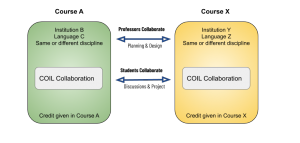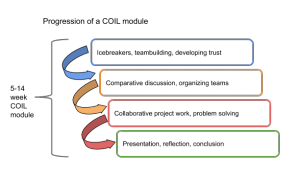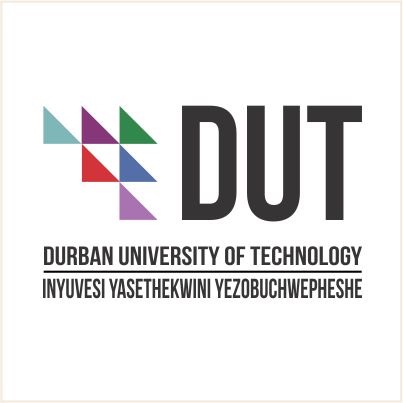COIL (Collaborative Online International Learning)
COIL courses bring together two or more courses from different countries through asynchronous, project-based modules.
Imagine a course that breaks through the physical, technological, and social boundaries to bring you a learning experience like never before. In COIL courses, you will have an opportunity to work with peers who live and study in another country, who may be at a different stage of their education, and who may not speak fluent English. The COIL approach allows your ideas and your voice to intermingle with the conversations happening in classrooms and research institutes all over the world! You and your global peers will work together to create a project that will be rich in perspectives.
Teaching COIL
COIL modules are an exciting and useful way to invigorate any class. By moving teaching and learning into an international context, instructors and students can see how their ideas and practices impact people from other countries and cultures. COIL courses encourage creativity, dialogue, and collaboration. In fact, it is the collaboration that is the most valuable part of the COIL approach. In addition, COIL is a flexible methodology that is based on the needs and realities of the global context. COIL course can:
- Bring courses from various disciplines together
- Help student become active learners
- Encourage teamwork, cooperation, and collaboration
- Emphasize cross-cultural interactions and understanding
- Be flexible in terms of timing and length
- Are a graded activity in each participating class
- Can use any technology tools that serves the learning goals
Visually, COIL can be represented as:

FDU’s COIL approach currently partners with institutions or courses that are taught in English.
WHAT ARE THE COMPONENTS OF A COIL MODULE?
Effective COIL collaborations follow a recognized progression through specific phases.
- The team building phase includes introductions and icebreakers, along with discussions and activities designed to help students get to know and feel comfortable working with one another online and across cultures.
- The next phase includes comparative discussions and organizing the project that teams of students will be working on. This phase prepares students for effective collaborative project work.
- The project phase is focused on the main activity for the collaboration. This is the time that students apply their knowledge, create something together or have substantive discussions around the topic of the collaboration.
- The final phase involves the presentation of work completed (in any format agreed upon by the collaborating professors), reflection on both the content of the module and the intercultural aspects of the collaboration, and concluding.

HOW IS A COIL MODULE DEVELOPED?
COIL planning begins with collaboration between professors from different institutions who want to bring intercultural and global learning into their classes.
Professors work together to:
- Define student learning goals
- Determine the length of the interaction
- Design comparative and collaborative activities
- Select methodology and technology tools for collaboration
- Monitor student work and learning
Students work together to:
- Develop effective international/intercultural teams
- Discuss course assignments and content
- Complete a project-based activity as part of their coursework
- Reflect on both the academic content of the course and the intercultural exchange that takes place
Adapted from: https://online.suny.edu/introtocoil/suny-coil-what-is/
Additional Resources
VE/COIL Research:
- Introducing Virtual Student Exchange in international university education
- Guide to COIL Virtual Exchange
- The effectiveness of Collaborative Online International Learning (COIL) on intercultural competence development in higher education
- Inclusive internationalisation: do different (social) groups of students need different internationalisation activities?
- Erasmus+ virtual exchange – Intercultural learning experiences : 2020 impact report
- Past Presentation Summarizing Research at IIGE
- The power of international online conversations: higher education teachers’ reflections on their impact on academic development
- The Impact of International Virtual Exchange on Participation in Education Abroad
- The Impact of International Virtual Exchange on Student Success
- Virtual Exchange: Evidence and Analysis to Advance the Field
VE/COIL Initiatives/Projects
- AAC&U VE/COIL Initiative
- UniCollaboration
- Institute for Innovative International Education (IIGE) at Kansai University
- University of the Free State iKudu Project
- Stevens Initiative
VE/COIL Conferences and Publications
- International Virtual Exchange Conference (IVEC) taking place October 30 – November 1, 2023 in São Paulo Brazil and online
- Journal of Virtual Exchange
VE/COIL Communities
General Research Resources:
Our Global Partners


CONTACT Information:
I am happy to answer all of your questions as well as help you get started with COIL. Please take a moment to tell me how I may help by filling out a brief questionnaire:
For FDU faculty wishing to teach COIL courses: COIL Interest Form
For FDU students wishing to enroll in a COIL course: Student Interest Form
For prospective international partners: COIL Partner Form
For more assistance, please e-mail Dr. Agie Markiewicz-Hocking at a.markiewicz@fdu.edu